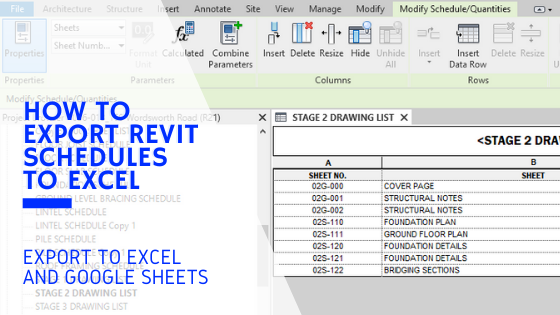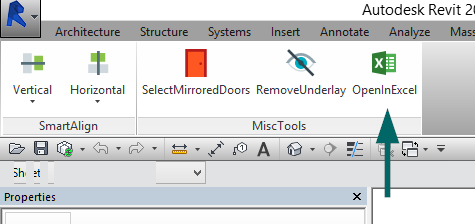Boost Your Layout Video Game with Vital Revit Add Ins
Wiki Article
Excel-to-Revit: A Game-Changing Workflow for Architectural Style - Revealing the Keys
Presenting excel-to-revit, the game-changing operations that will certainly transform your design process. With excel-to-revit combination, you can improve your architectural style, unlock effectiveness, and maximize collaboration within your group. Obtain all set to take your building design to the next degree with excel-to-revit!The Power of Excel-to-Revit Combination

Think of the benefit of having the ability to upgrade and edit job data in Excel, and promptly see those modifications reflected in your Revit version. No much more hand-operated data entry or tiresome updates. With Excel-to-Revit combination, you can save time and decrease mistakes by leveraging the power of Excel's solutions and functions to automatically generate precise information in Revit.
Not just does this combination enhance efficiency, but it likewise improves cooperation amongst staff member. You can easily share Excel documents with associates, that can then import the information into their Revit designs. This advertises a seamless exchange of details and guarantees that every person is dealing with one of the most up-to-date data.

Improving Building Style With Excel-To-Revit
Simplifying architectural layout is simplified with making use of Excel-to-Revit (import excel into revit). With this powerful assimilation, you can optimize your process and conserve important time throughout the layout process. By leveraging the abilities of Excel and Revit, you can flawlessly transfer information in between both platforms, removing the need for hands-on information entry and lowering the risk of errorsExcel-to-Revit enables you to import and export information effortlessly, enabling you to quickly upgrade and modify your architectural styles. You can create routines, calculate quantities, and produce records in Excel, and afterwards transfer that information directly right into your Revit version. This integration makes sure that your layout details is always up-to-date and synchronized, getting rid of the demand for hand-operated updates and reducing the chances of variances.
By utilizing Excel-to-Revit, you can additionally capitalize on the effective computational capabilities of Excel. You can carry out complicated computations, examine information, and automate repeated tasks, all within Excel. With simply a couple of clicks, you can import the outcomes back into Revit, enabling you to make educated style decisions and optimize your architectural layouts.
Opening Performance: Exploring the Excel-to-Revit Workflow
Maximize your performance by seamlessly incorporating Excel and Revit for an extra effective process. With the Excel-to-Revit workflow, you can unlock an entire brand-new level of efficiency in your architectural layout procedure. By making use of the power of Excel's data monitoring capacities and integrating it with the versatility and precision of Revit, you can simplify your layout process and save beneficial time.One of the essential advantages of this assimilation is the ability to import and export information in between Excel and Revit. This implies that you can conveniently move project details, such as space timetables or material amounts, from one software program to the other, removing the requirement for hands-on data access and minimizing the chances of mistakes. You can likewise develop custom-made formulas and computations in Excel to automate repetitive jobs and carry out intricate computations, which can after that be perfectly incorporated right into your Revit models.
Additionally, the Excel-to-Revit operations permits better coordination and collaboration in between staff member. With Excel serving as a central data hub, several group participants can work on different elements of the job at the same time, sharing and upgrading info in real-time. This not only boosts interaction but additionally ensures that everybody is dealing with one of the most updated data, eliminating the threat of inconsistencies.
Making Best Use Of Cooperation: Excel-to-Revit for Architectural Teams
By seamlessly incorporating Excel and Revit, building groups can considerably boost cooperation and accomplish extra efficient style results. When using this powerful operations, you can conveniently transfer data in between Excel spreadsheets and Revit designs, enhancing the style process and improving communication among group members.In addition, by leveraging Excel's powerful estimation capacities, you can carry out complex estimations and analysis on your design information, driving and supplying valuable understandings notified decision-making. This assimilation likewise enables you to export information from Revit to Excel, allowing you to create comprehensive records, charts, and charts for presentations and evaluation. This collaborative operations promotes reliable communication and control among staff member, as Excel acts as a main center for data monitoring and sharing.
Overall, by accepting the Excel-to-Revit workflow, building groups can accomplish greater levels of partnership, performance, and accuracy in their layout process. revit tool. This integration equips groups to work with each other seamlessly, making certain that everyone is on the very same page and adding to the success of the job
Introducing the Secrets of Excel-to-Revit Combination

One of the keys of Excel-to-Revit integration is the capability to utilize the power of formulas and calculations in Excel to drive specifications and create facility geometries in Revit. You can link Excel spreadsheets to Revit households, allowing you to input information straight into the spread sheet and have it automatically upgrade in the Revit design. This improves the layout process and guarantees accuracy and uniformity across the project.
Another trick is the capability to develop custom routines and reports in Excel, utilizing data drawn out from Revit. This enables you to visualize and analyze task details in a means that is not feasible within Revit alone. You can conveniently create amount liftoffs, expense quotes, and job timelines, offering important insights for decision-making and project management.
Furthermore, Excel-to-Revit assimilation makes it possible for reliable partnership among team members. Numerous customers can deal with the exact same Excel spreadsheet concurrently, making it much easier to collaborate and track changes. You can additionally make use of Excel's commenting function to offer feedback or connect style revisions.
Final Thought
So there you have it, the keys of excel-to-revit assimilation have been unveiled. This game-changing workflow has the power to improve architectural style, unlock effectiveness, and make the most of partnership for building teams. By integrating the power of Excel and Revit, designers can currently function a lot more effectively, conserve time, and generate much better styles. Why wait? Begin including excel-to-revit assimilation right into your building style process today and transform the way you work.With simply a couple of clicks, you can import the results back into Revit, permitting you to make enlightened style decisions and maximize your building styles.
By using the power of Excel's data monitoring capacities and integrating it with the flexibility and accuracy of Revit, you can enhance your design procedure and conserve important time.
By seamlessly incorporating Excel and Revit, architectural teams can substantially enhance collaboration and achieve extra effective design end results. When using this effective process, you can easily move data in between Excel spreadsheets and Revit versions, improving the layout procedure and enhancing interaction among group participants.Moreover, revit plugins by leveraging Excel's effective computation abilities, you can carry out complex estimations and evaluation on your style information, driving and giving important understandings informed decision-making.
Report this wiki page